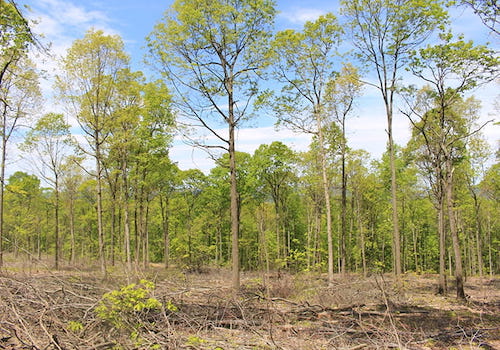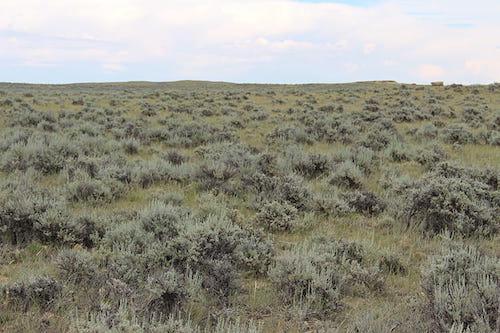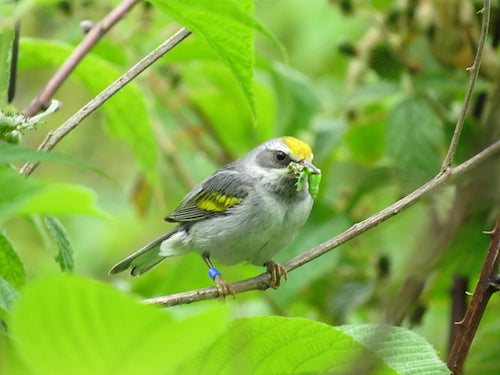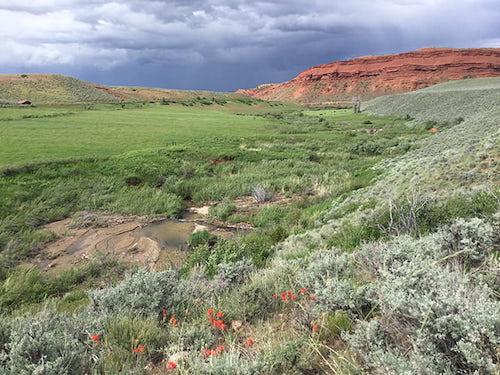 Golden-winged warbler male (left), and greater sage-grouse male (right). Photos by Laura Erickson and Conservation Media.
Golden-winged warbler male (left), and greater sage-grouse male (right). Photos by Laura Erickson and Conservation Media.
By Brianna Randall, Working Lands for Wildlife·Aug 13, 2019
What does a football-sized upland bird that struts around western sagebrush country have in common with a graceful finger-sized songbird that migrates between eastern forests and tropical jungles? Agricultural producers who are helping them thrive on private working lands.
Although you might not think so at first glance, sage grouse and golden-winged warblers share some striking similarities. Populations of both species have dwindled over the past century, but their future is looking brighter thanks to people coming together to conserve the landscapes these birds depend upon.
Through Working Lands for Wildlife, the Natural Resources Conservation Service is conserving habitat for these two birds and dozens of other at-risk wildlife species, while also benefiting agricultural operations. Working Lands for Wildlife provides landowners with technical and financial assistance through the Farm Bill to invest in win-win practices—like sustainable ranching or forestry—that create more productive working lands and healthier habitat.
Since 2010, Working Lands for Wildlife's Sage Grouse Initiative has worked to conserve sagebrush country in 11 western states and has partnered with 1,800 ranchers to conserve over 7 million acres of working rangeland. Working Lands for Wildlife, which prioritizes conservation for the golden-winged warbler, was launched in 2012 and has partnered with 300 landowners to conserve 17,000 acres of working forests in six Appalachian states.
Here’s a closer look at what these two birds have in common, and how NRCS and partners are helping to conserve the working lands they depend upon:
1. They need open areas to nest.
Golden-Winged Warbler: These delicate songbirds build nests on the ground in deciduous forests in Appalachia and the Great Lakes each spring. They look for areas with dense, low-lying shrubs to protect their nests from storms and predators. Shrubs grow in young, regenerating forests where tall trees aren’t blocking the sunlight. These open patches can be tough to come by, since most of our eastern deciduous forests are dominated by mature closed-canopy stands.
Luckily, private forest owners are stepping up to create healthy forests that are a mosaic of different tree heights, ages, and species. NRCS and conservation partners help forest owners apply practices that mimic natural disturbances—like wind, fire, or falling trees—which would have historically created open patches of new forests. Targeted practices include weed control, brush management, timber harvest, and prescribed burning.
Recent research funded by the NRCS Conservation Effects Assessment Program shows that nesting golden-winged warblers will re-populate a one-quarter to half of all young forests created through conservation practices. Plus, sustainable forestry benefits a host of other wildlife that rely on young forests, including popular game species like white-tailed deer, wild turkey, American woodcock, and ruffed grouse.
 Stand of trees where timber has been harvested to benefit the golden-winged warbler. Photo by Jeff Larkin
Stand of trees where timber has been harvested to benefit the golden-winged warbler. Photo by Jeff Larkin
Pictured here is a project conducted with a forestland owner that harvested timber to help mimic natural processes of opening up patches of forest areas for the benefit of the golden-winged warbler.
Sage Grouse: These bulky birds perform their mating ritual in the spring, congregating in wide-open sagebrush country where the females can nest safely nearby. Research has shown that sage grouse avoid nesting near conifer trees, which are prime perches for predators. Conifers also reduce water availability in arid regions, and crowd out nutritious native plants that provide forage for livestock and wildlife.
Natural disturbances like wildfire used to keep trees in check. But a century of fire suppression has led to an invasion of these conifers onto productive grazing lands across the American West. This is bad news for sage grouse and other sagebrush-dependent wildlife, as well as the ranchers who need reliable water and forage for their livestock.
NRCS and conservation partners help landowners restore rangelands by removing invading conifers. A long-term study of conifer removal in Oregon, also funded in part by the Conservation Effects Assessment Project, shows that three years after trees were cut, one-third of marked sage grouse females were once again nesting on the restored grazing lands. The landscape-level conifer management practices in southern Oregon have increased the area’s sage grouse population by 12 percent over the past decade.
 Sage grouse depend on sagebrush landscapes for survival. Photo by Justin Fritscher.
Sage grouse depend on sagebrush landscapes for survival. Photo by Justin Fritscher.
2. They require diverse habitats throughout the year.
Golden-Winged Warbler: Like most wildlife, golden-winged warblers will not thrive in homogenous habitat where trees are all the same size or species. While these warblers use shrubby young forests to nest in the spring, they move their fledglings to denser forests during the summer for protection and to hunt for caterpillars. Structurally complex mature forests are also important since they comprise the main matrix of the forests these warblers fly through.
Landowners also benefit when they have diverse, complex forests. Invasive species, disease, and historic unsustainable harvest practices not only reduce habitat quality, but also the recreational economic opportunities for forest owners. Working Lands for Wildlife provides cost-share for private forest owners looking to create healthy, diverse stands of trees and shrubs through a series of sustainable treatments and management options.
 A female golden-winged warbler eats a tasty snack in a young forest. Photo by Jeff Larkin.
A female golden-winged warbler eats a tasty snack in a young forest. Photo by Jeff Larkin.
Sage Grouse: Although their diet is comprised primarily of sagebrush leaves in the winter, these birds dine on diverse herbaceous plants in the summer and fall to fatten up. As upland sagebrush habitats dry out, hens and their chicks move to wet places along streams, ponds, meadows, or irrigated fields to eat wildflowers, leafy plants, and insects.
Ranching with an eye toward maintaining diverse, native plant communities on western rangelands helps protect soil, retain water, prevent the spread of weeds and wildfires, and provide nutritious food for wildlife and livestock. Research has shown that sustainably managed grazing lands also grow more of the bugs that sage grouse chicks prefer to eat. Thousands of ranchers are partnering with Working Lands for Wildlife on grazing practices that conserve or boost native plant abundance and diversity, which pays dividends for current and future generations.
 Mesic areas provide food for sage grouse chicks during the summer. Photo by Jeremy Maestas
Mesic areas provide food for sage grouse chicks during the summer. Photo by Jeremy Maestas
3. They use large, mostly privately owned landscapes.
Golden-Winged Warbler: In Appalachia, 80 percent of the forestland where these warblers breed is privately owned. The same goes for the birds’ wintering habitat in Central America, where local coffee producers are partnering with the USDA’s international program on sustainable, incentive-based conservation projects that restore tropical forests for wildlife and rural communities.
Through Working Lands for Wildlife and the NRCS’ Regional Conservation Partnership Program, landowners receive cost-share and technical know-how to improve the health and diversity of hardwood forests in Appalachia and the Great Lakes. Sustainable forest management helps “reset the clock” on degraded low-value forests, regenerating more productive forest stands that benefit landowners along with 65 at-risk species of birds, mammals, and reptiles.
 Forest landowners can use sustainable forestry practices to improve the health of their forests and habitat for wildlife. Photo by Jeff Larkin.
Forest landowners can use sustainable forestry practices to improve the health of their forests and habitat for wildlife. Photo by Jeff Larkin.
Sage Grouse: Sage grouse occupy a vast area spanning nearly 200 million acres across 11 U.S. states and 2 Canadian provinces, nearly half of which is privately owned. These iconic birds need large expanses of intact habitat to survive and require conservation strategies that work across property boundaries. Collaboration between diverse partners is working to save the bird, support ranching communities, and conserve the vast sagebrush sea that sustains rural communities and more than 350 species.
 Both sage grouse and livestock benefit from open sagebrush landscapes. Photo by Tim Griffiths.Both sage grouse and livestock benefit from open sagebrush landscapes. Photo by Tim Griffiths.
Both sage grouse and livestock benefit from open sagebrush landscapes. Photo by Tim Griffiths.Both sage grouse and livestock benefit from open sagebrush landscapes. Photo by Tim Griffiths.
Leran More
Learn more about Working Lands for Wildlife by watching “Thinning Forests to Save the Birds” on the NRCS YouTube channel or visiting the “Managing for Healthy, Diverse Forests” multimedia story.
Brianna Randall is a writer for Working Lands for Wildlife, an NRCS-led partnership for wildlife conservation on ag lands. She can be reached at brianna.randall@gmail.com.


